

[ 2 | TIME FOR ANOTHER LOOK]
CEE is currently one of the most
overlooked regions for private equity
investment. Having emerged from its
communist past during the 1990s,
grown and developed in the 2000s,
and weathered the recent financial
crisis rather well, the region is now an
integrated part ofthe European and
global economies. CEE also boasts an
increasingly sophisticated private equity
deal market led by experienced general
partners specialising in the region and
investing in all segments of the economy.
For the purposes of this paper CEE generally
refers to the 10 EU member countries and two
candidate countries from Central and Eastern
Europe. It does not include Russia, the CIS,
Ukraine and Turkey. See statistical footnotes and
“The Region” for further details.
Despite the region’s successful ongoing
transformation to a €1 trillion plus economy
with more than 20 years of private equity activity
experience behind it, CEE seems to have dropped
out of the private equity headlines and off some
limited partners’ radar screens.
We think it is time to have another look. Today, the
region’s funds represent an important component
of European private equity exposure. They provide
access to a region that continues to demonstrate
compelling private equity fundamentals and
attractive returns as well as a clear and evidenced
macro convergence story that will continue to
drive superior growth for the foreseeable future.
Thanks to successful EU integration, CEE offers
investors developing market opportunities but with
developed market risk.
The following pages set out 10 of the many
reasons we believe CEE deserves renewed
consideration.
The CEE region is at the heart of Europe,
with over 28% of the EU’s land mass¹,
23% of its population¹ and a GDP
nearly equal to that of the Nordic region.
PEOPLE ¹
OF GDP ¹
SQ.KM ¹
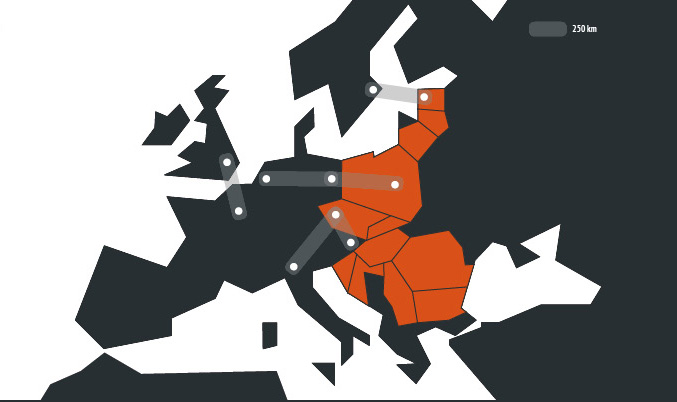
Following successive waves of EU accession, nearly
all of CEE is politically integrated into the EU.
The region boasts a developed legal, regulatory
and judicial system that reduces risk and today
provides the certainty of developed markets,
something no other emerging region in the world
can offer or looks likely to be able to offer in the
foreseeable future.
In addition, CEE has developed into a key trading
partner, manufacturing base and service supplier
for the main markets of the EU, taking advantage
of generally borderless access, attractive cost
structures and overall lower corporate tax rates.
High levels of education and a long tradition of
technical and engineering training combined
with flexible labour markets complete the open
and welcoming investment environment. As CEE
deepens its economic integration, these advantages
will continue.
Historically characterised as an emerging market, it
is clear that CEE is now an integral part of Europe’s
economy. Yet it continues to offer investors some of
the growth and development opportunities seen in
the emerging world. Emerged and still emerging,
CEE is located at the heart of Europe’s future.
[ 4 | TIME FOR ANOTHER LOOK]
Private equity is not new to CEE. Since the
first funds were raised in the early 1990s,
the region has put in place the full eco-
system necessary to support the private
equity investment lifecycle.
Twenty years on, this system includes not only
experienced banks willing to lend and professional
advisers (legal, financial and operational) able to
implement, but the laws and tax structures that
have led to a convergence of CEE private equity
deal making to that of developed markets.
Exit infrastructure is also robust, with strong
and persistent FDI flows to the region, a growing
M&A appetite from local corporate buyers, and
active public markets for debt and equity in many
countries. For example, Poland, home to the
region’s largest stock exchange, had the largest
number of IPOs among European stock exchanges
every year between 2009 and 2012¹.
Importantly, at the same time that private equity
has matured in CEE, so have the management
teams delivering results for private equity-
backed investments. The region is well known
for its entrepreneurial talent. This is coupled
with a growing cadre of highly experienced and
accomplished professional managers, schooled by
multinational corporations and showing a high
degree of interest in working with private equity.
The managers and entrepreneurs of the region
have weathered not only the initial transition but
multiple crises imported from developed markets
over the past two decades, making them well
equipped to add value in the coming years.
Today's CEE private equity market includes a wide
variety of funds and fund managers, offering
investors exposure to buyout, expansion and
venture capital as well as distressed and turnaround
strategies. Fund managers employ a range
of regional, sub-regional and national investment
strategies. Mezzanine funds are active and provide
additional financing capacity. The experience of
these managers is significant: a recent independent
survey of CEE GPs showed an average tenure at the
partner level of over 13 years, comparable to many
established western European buy-out houses.
At the same time, the national private equity
associations, some established over a decade
ago, work closely with the EVCA, and ensure
a professional and responsible approach
to investment. The strong involvement of
the European Bank for Reconstruction and
Development (EBRD) and the European Investment
Fund (EIF) in the region’s funds also ensures
a tradition of investor friendly fund structures,
Economic, Social and Governance (ESG) reporting
and a high degree of conformity to international
norms and standards. Finally, the positive role
of private equity in the region’s transition has
been appreciated by governments as well as the
press, creating a positive environment in which
to operate.
While fundraising for CEE private equity was robust for a short
period immediately prior to 2008, these amounts still remained
low compared to the GDP of the region and the sizeable
fundraisings seen in other markets. Fundraising for CEE private
equity between 2008 and 2011 was on average 0.098% of GDP,
while for all of Europe it was 0.303%¹ and 0.239% for Asia¹.
FUNDRAISING AS % OF GDP
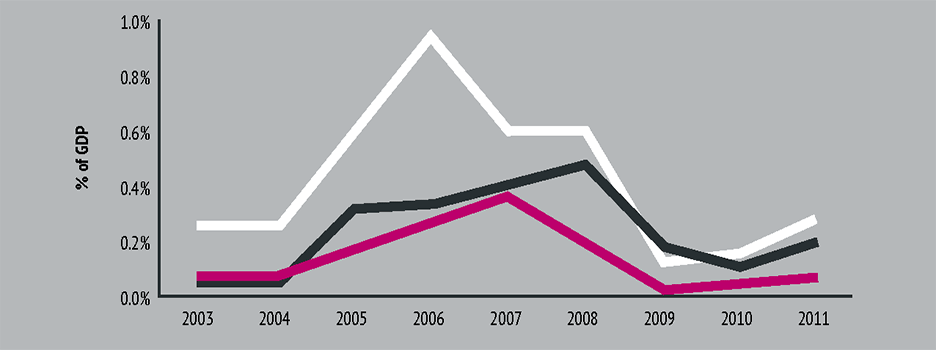
INVESTMENT AS % OF GDP
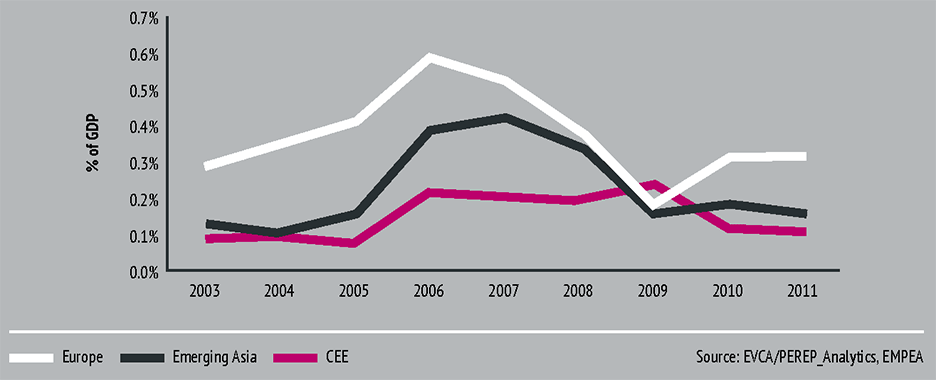
Since 2009, LPs’ capital has continued to flow into other emerging markets,
while new funding directed to CEE lagged, subsiding to levels seen in the
early phase of the region’s development. With this decline, the level of
investment during the period 2008–2011 well exceeded new funds raised:
investment was €7.4bn in CEE vs. €4.5bn of fundraising.¹ It is clear that as
investment periods of the funds raised prior to 2008 expire, the level of
available private equity funding for the region has reached a cyclical low.
Today’s CEE GPs have grown up in the region, logging a substantial number
of deals, accumulating truly local insight and gaining experience in
navigating the specificities of the region’s markets. Similar to the region’s
entrepreneurs CEE’s PE fund managers have weathered the local impact of
multiple global crises and are well positioned to use the insights gained in
difficult periods in selecting future investments.
From an LP perspective of manager and market selection, the mature
CEE landscape contrasts with hot emerging markets where a plethora of
new funds and team configurations often confront the investor. CEE GPs
have already largely matured and identified their market approaches and
specialisations, providing investors with a clear choice.
 GLOBAL
GLOBAL
 CEE
CEE
 CEE PRIVATE EQUITY
CEE PRIVATE EQUITY
1989 1990 1991 1992 1993 1994 1995 1996 1997 1998 1999 2000
2001 2002 2003 2004 2005 2006 2007 2008 2009 2010 2011 2012

Berlin Wall falls

Maastrict Treaty
signed

Asian financial
crisis

Euro introduced

NASDAQ peaks
– 10 March

Democratic
elections take
place across CEE

EBRD begins
operations

Velvet Divorce in
Czech Republic
and Slovakia

Dayton Accords
signed

Impact of the
Russian crisis
felt in CEE

First 3 CEE
countries
(Poland, Czech
Rep., Hungary)
join NATO; 8
more join later

First PE fund
raised for CEE

Hungarian
Venture Capital
Association
founded

First PE-backed
IPO on the
Warsaw Stock
Exchange

Wave of country focused
PE funds
raised
New fund
managers
established in
the region

First high-yield
bond offered for
a CEE PE-backed
company

First “third
generation” fundraised by a CEE GP
First CEE PE-backed
IPO on
Nasdaq

Wave of
regional-focused
CEE funds raised

Dotcom bubble
bursts
9/11 triggers
War on Terror

Skype, originally
an Estonian
product, releases
first version

First wave of EU
accession – 8
CEE countries

CEE countries
join Schengen
borderless travel
zone
Slovenia joins
the euro area

Lehman
Bankruptcy
sets off global
financial crisis

Poland the only
EU country to
register positive
growth

Greek crisis
dominates
European news

Estonia joins the
euro area

First mezzanine
fund dedicated
to CEE

First leveraged
buyout in CEE

Next wave of
fundraising
begins
First ever CEE
fund over EUR
1bn raised
First > EUR 1bn
deal

CEE investment
pace exceeds
EUR 2bn

Establishment
of EU-supported
venture capital
funding
programs across
CEE

40th PE-backed
company goes
public on
Warsaw Stock
Exchange

First listing of
a PE-backed
company from
CEE on the
New York Stock
Exchange
The CEE private equity market has outperformed other private
equity markets and comparable public market indices over the
long-term time horizon of 10 years.
The return data presented here is quantified by a special analysis for this
paper conducted by the CEE region’s largest private equity investor, the
European Bank for Reconstruction and Development (EBRD)¹. The data set
includes more than 800 underlying investments, over 70% of which are
exited. This is the most representative sample of returns for the CEE region.
It shows CEE private equity returning 4% more than Thomson Reuters’
European private equity returns in euros over the same period.
EBRD also points out that this analysis provides a conservative view of the
returns for several reasons. First, there is no survivor bias. EBRD has included
all funds from its own portfolio, successful or not, raising further money
or not. In most other sets of available return data for private equity, failed
managers simply stop reporting and their weaker performance is excluded.
Second, the dataset includes non-institutional quality funds (supported by
EBRD as part of its development mandate), that would be unlikely to attract
institutional investors. EBRD estimates that nearly 20% of its CEE portfolio by
capital is invested in such funds.
At the end of 2011, the EBRD analysis shows a 2.09x gross return in euros
from CEE investments (both realised and partially realised, since inception).
This represents €3.4 bn of cost from more than half of all investments in
the sample analysis and by all means a statistically significant sample. The
unrealised portfolio is held slightly above cost, indicating that the financial
crisis has not endangered the remaining portfolio, while the partially realised
portion shows a 2.29x (gross) return in euros, indicating there may be more
good news to come in future exits.
GPs and LPs active in CEE confirm that the region’s
comparative advantages mean CEE can continue to
deliver attractive returns: economic growth through
continued convergence, maturing entrepreneurs
willing to sell their companies, seasoned general
partners with strong in-region local experience,
relatively low reliance on debt for return
generation, and currently cyclically low levels of
private equity funding. The present point in the
fundraising and investing cycle is an opportune
time for investors to once again consider the future
potential of the CEE region.
These returns show that the region has
outperformed most emerging markets, where
many LPs are now focusing resources as well as
developed markets, where the bulk of LP portfolios
are concentrated.
Comparison of horizon returns to 31.12.2011

10-year horizon net PE returns, 31.12.2011
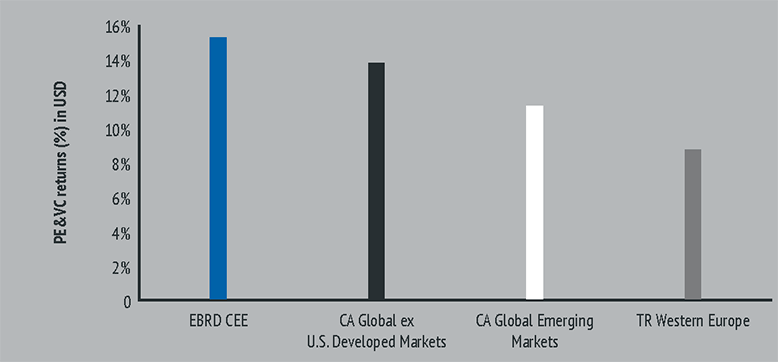
EBRD analysis of CEE PE gross returns since inception
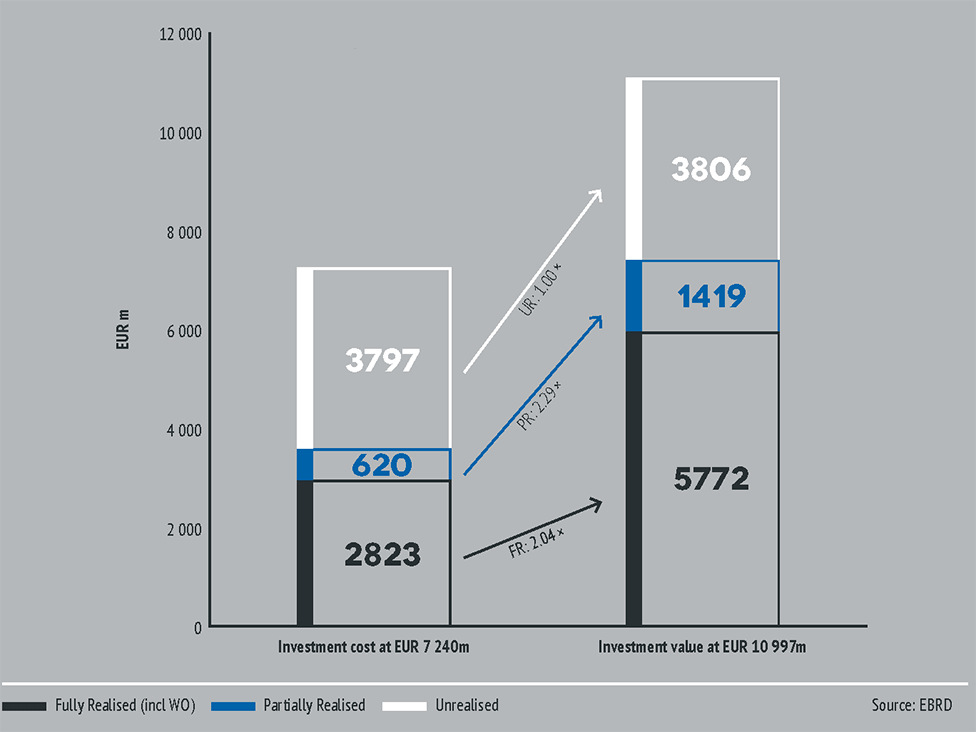
The pool of investment opportunities in CEE today
is unique: it is largely composed of businesses still
in their first generation of ownership but with up to
20 years of development already behind them.
After years of hard work and success, ageing first generation
business owners are often looking to realise on their efforts.
Be it for health or lifestyle issues, because of a realisation
that the business must consolidate to grow, diverging
interests of the founding team or the pressures of increased
management complication as companies grow, an increasing
wave of owner/managers are looking for liquidity. With
a clear lack of a “keep it in the family” culture and mind
set across the CEE region, these successful businesses are
increasingly available for private equity investment.
Private equity firms are taking advantage of this unique
landscape. Over 58% of their deals are purchases from
the original business founders, according to a recent
independent GP survey. The same survey found 93% of deals
completed by the surveyed GPs were primary transactions,
buying directly from business owners rather than other
financial sellers. Sales between private equity firms in
CEE were limited to only 7% of the total deals done. The
implications are clear: investors in CEE private equity funds
are able to access new and developing opportunities that
are ripe for first time private equity ownership.
CEE demonstrates another difference to European
markets: the substantial growth in the pool of
investee companies. Statistics show that well
after the initial unleashing of capitalism, midmarket
businesses are providing a growing pool of
companies ripe for private equity funds investing in
the region. With continuous rapid company formation
and new generations of company founders building
their businesses, deal potential continues to expand.
This growth also indicates the strong potential for
consolidation and buy-and-build, long proven private
equity strategies.
The rapid transformation from communism has
solidified CEE’s strong entrepreneurial roots and
enhanced a culture that admires initiative and
promotes new business formation. Combined with its
strong engineering and technical traditions, a strong
pipeline of venture and early stage opportunities
complements the well-established middle market.
DEAL SOURCES
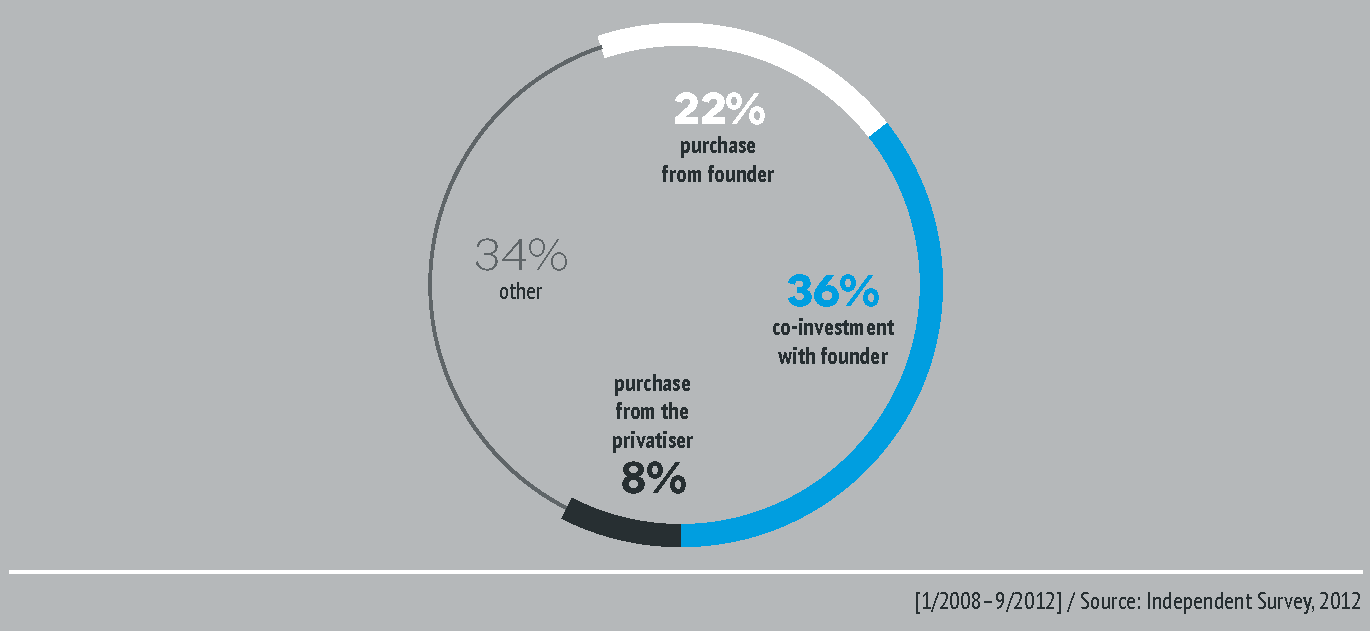
DEVELOPMENT OF NUMBER OF ENTERPRISES IN CEE AND EU
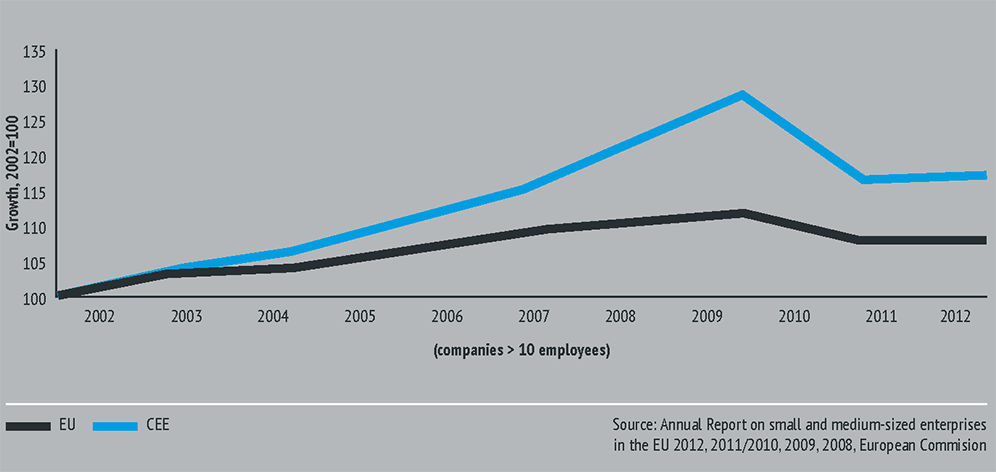
Unashamedly copying western laws, standards and lifestyles as they
sought to rebuild economies and re-join their western neighbours,
CEE is today operating by the same rules and models used in the
European and US markets. Politicians are constrained by the imperative
of maintaining western integration, a stabilising force absent in other
emerging regions.
These same factors are also those fuelling the strong aspirational
drive behind the economic success in CEE over the past two decades,
and are giving rise to a consumer society with material and growing
levels of disposable income.
The increasing wealth has created significant
new opportunities for private equity owned
businesses to address the increasingly diverse and
sophisticated needs and aspirations of the region’s
populace and to address their growing purchasing
power. Consumer goods, retail, healthcare, financial
and leisure sector investments are increasingly
the focus of the region’s private equity funds and
a likely source of continued deal generation.
The convergence story is set to continue for at least
the next two decades, as there remains significant
scope for further growth and catch-up. The 50%
gap in per capita GDP to the EU’s wealthiest
members illustrates the further potential of the
convergence dynamic. The under-representation of
services in the economy compared to other markets
shows that additional growth and development
is to come. All of this will create a growing
opportunity for private equity.
GDP PER CAPITA AT PPP
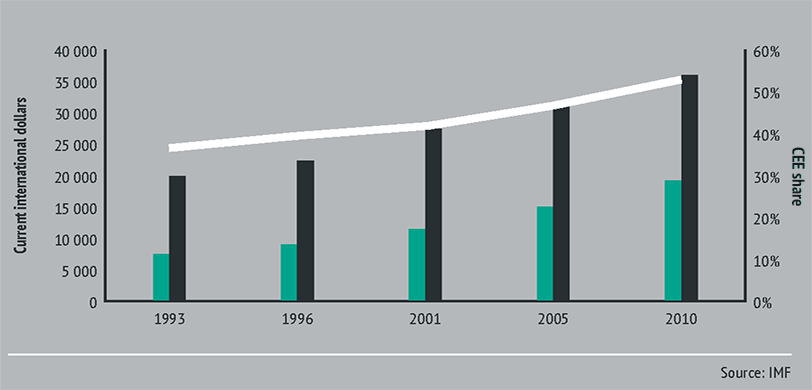
EMPLOYMENT IN SERVICES

Poland, with a GDP of €381bn in 2012,¹ is the largest country in the region
and the leader of the EU growth tables since 2008. It is the only European
country not to have experienced a recession over the past 20 years.
REAL GDP GROWTH
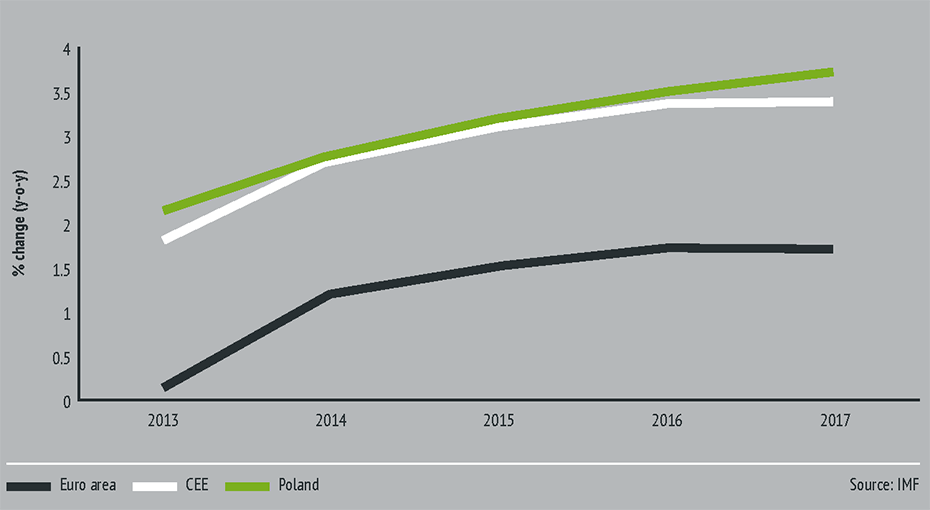
Poland’s real GDP growth through the recent crisis
totalled 18%¹ in the period 2008–2012, at a time
when the GDP of the euro area shrank by 1%. Even
Europe’s “tiger”, Turkey, recorded just 17% growth in
the same period. But CEE is not just about Poland:
many CEE markets are also recording strong
fundamental growth and offer attractive macro
stories.
Poland’s performance, and that of the region
generally, has been driven by the continued
momentum of its industry, strong consumer
demand, prudent debt and deficit levels and stable
financial and political systems.
At the same time, CEE has generally avoided the
excesses of the pre-crisis boom period. In smaller
countries where overheating did develop pre-
2008, such as the Baltic States, governments have
quickly undertaken the tough adjustment processes
needed to return to dynamic growth. Few other
markets have tackled their problems as resolutely
and successfully. Consumers, businesses and even
most governments now boast strong balance
sheets compared to their peers in other countries.
GOVERNMENT DEBT
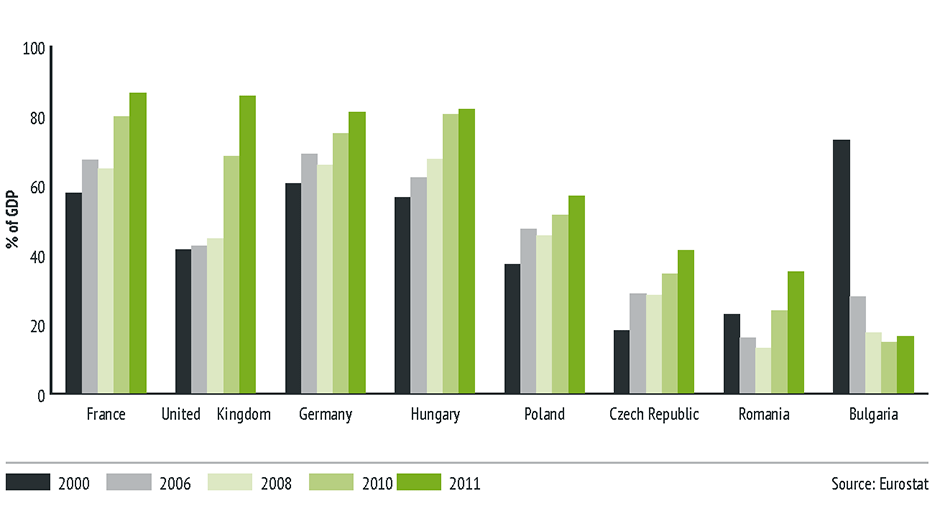
DOMESTIC CREDIT TO THE PRIVATE SECTOR
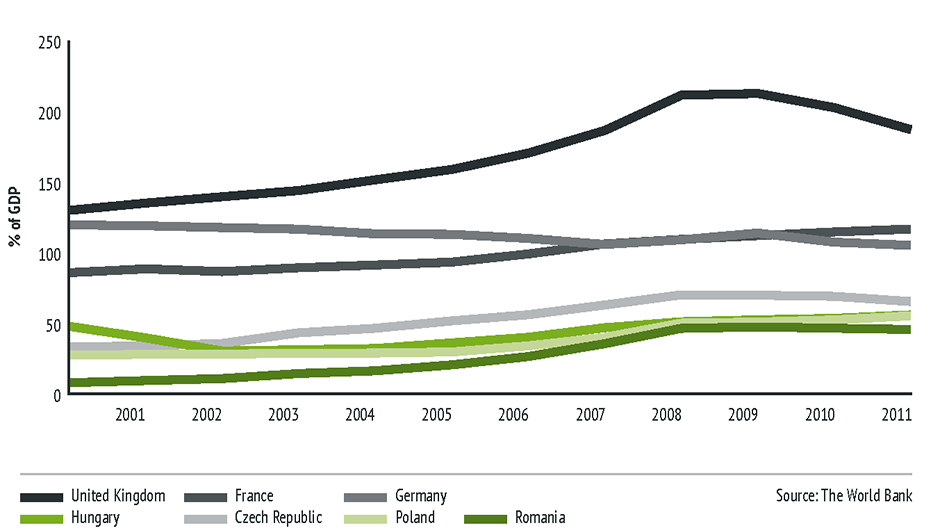
The region has attracted substantial amounts of
FDI over the years and is an increasingly popular
investment destination. Combined with the
substantial and continued inflow of EU cohesion
funds, confirmed in the latest EU budget, these
investments have catalysed the development of CEE’s
modern and networked infrastructure and cemented
its links into the European and world economy.
HOURLY LABOUR COST
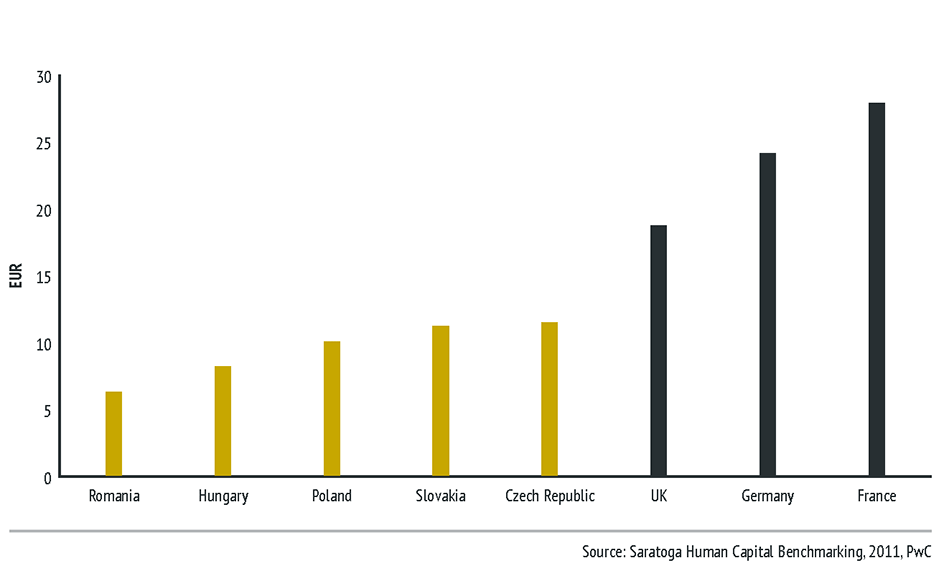
CEE offers hourly labour costs below European
levels, high levels of education, strong language
and organisational skills and attractive wage-
adjusted productivity comparisons to other
markets. Near-shoring and re-shoring into CEE’s
skilled labour pool and attractive fiscal regimes
is providing strong support for the region’s
production and service sectors. The strong growth
in shared service and R&D centres in the region,
as well as the growing outsourcing of business
processes and IT, have created nearly 250,000 jobs
across the region, 50% more than at the start of
the global financial crisis in 2008.¹ Capgemini,
General Electric, IBM, Hewlett Packard, Accenture,
Infosys and many others have already established
major service operations in the region.
For private equity, these flows have supported
a vibrant market for investment. From investing
in businesses that provide services to the
multinationals to developing retail chains
where the employees spend their earnings, the
region’s private equity firms have diversified their
investment activities and today show a similar
sectorial diversity as in other developed markets. In
addition, both foreign and local corporate investors’
continued demand for CEE market share supports
strong exit markets for private equity divestments.
FDI INWARD STOCK IN CEE, 2000 AND 2011
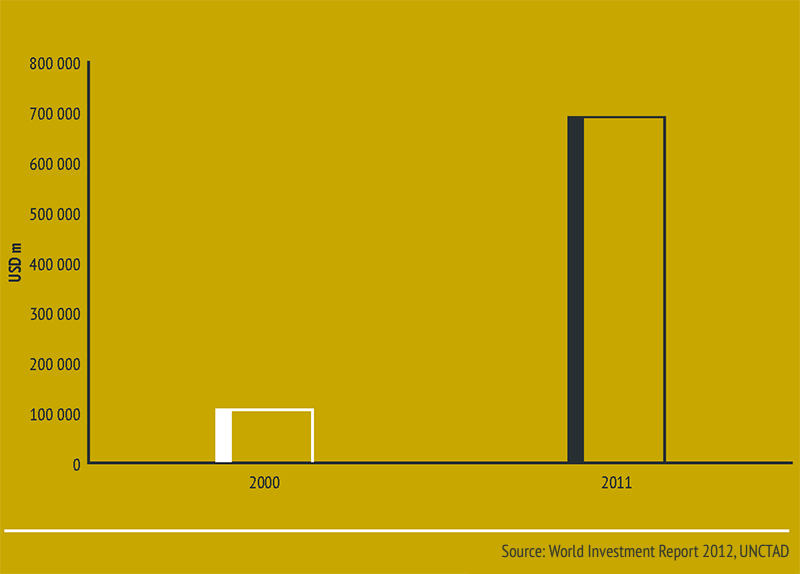
WAGE ADJUSTED LABOUR PRODUCTIVITY, 2010
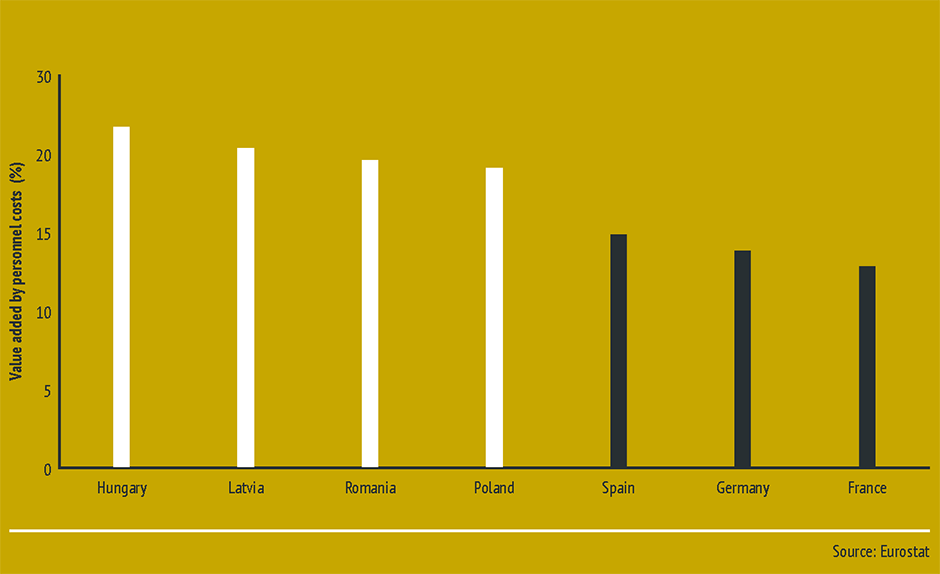
Globally today, private equity has to rely less on leverage
as a source of returns. But CEE has never been reliant
on leverage for its deal making and returns.
Buyout leverage in the CEE region was almost non-existent until 2003 and
then limited until around 2006, when both local and international lenders,
following global trends, increasingly provided debt for acquisition financing.
Despite that uptick in borrowing, the leverage market in CEE never reached
the same stage of overheating as in other developed markets, and the more
aggressive pre-crisis financing structures never made it to CEE’s mainstream.
Covenant light, bullet-only and deep subordination were all features
noticeable by their absence from CEE deals.
The independent survey of CEE GPs conducted for this paper¹revealed that
the average leverage level of respondents’ portfolios was only 3.1x debt to
EBITDA at the end of 2011, compared to 4.7x as reported by S&P LCD for all
of Europe.¹The same sources showed CEE deals done by the surveyed GPs
in 2011 had an average of 57% of equity in the capital structure against an
average of 47% for Europe in the same period.
Despite the downturn in global lending to buy-outs, lenders inside and
outside the region remain ready to support CEE private equity-backed
transactions with moderate leverage packages. The region’s GPs and lenders
confirm that leveraged private equity deals continue to get done.
DEBT TO EBITDA IN EUROPE AND CEE, 2011
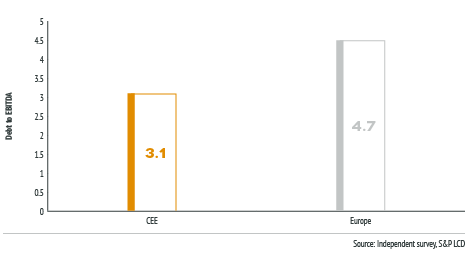
Central and Eastern Europe as presented in this paper is composed of
12 European countries that prior to 1990 were under communist rule.
All countries have established, democratically elected governments
and have (or are in the process of) adopting the EU’s legal and political
framework. The region today includes 10 members of the EU, as well as two
candidate countries engaged in the process of accession to EU membership.
CEE-focused private equity firms also frequently invest in the markets of
Turkey and Ukraine, both of which are not considered within the scope of
this report.
Among the EU member countries, all but Romania and Bulgaria are also
members of the Schengen borderless travel zone, creating a customsfree
union with most of the EU. This borderless travel area has helped
create a level of economic integration that has allowed CEE to become
a manufacturing engine within the EU, evidenced by the strong share of
exports in the GDP of the region. Romania and Bulgaria are currently in
negotiations to also join this zone.
Although the global crisis has reduced growth throughout the region
from prior levels, largely through the decline in exports as the European
and global economy has slowed, other indicators of stability are positive.
Government debt and deficit levels remain below other European countries.
These levels have been achieved while maintaining competitive levels
of taxation.
CEE COUNTRIES, 2011

CEE COUNTRIES, CONTINUED
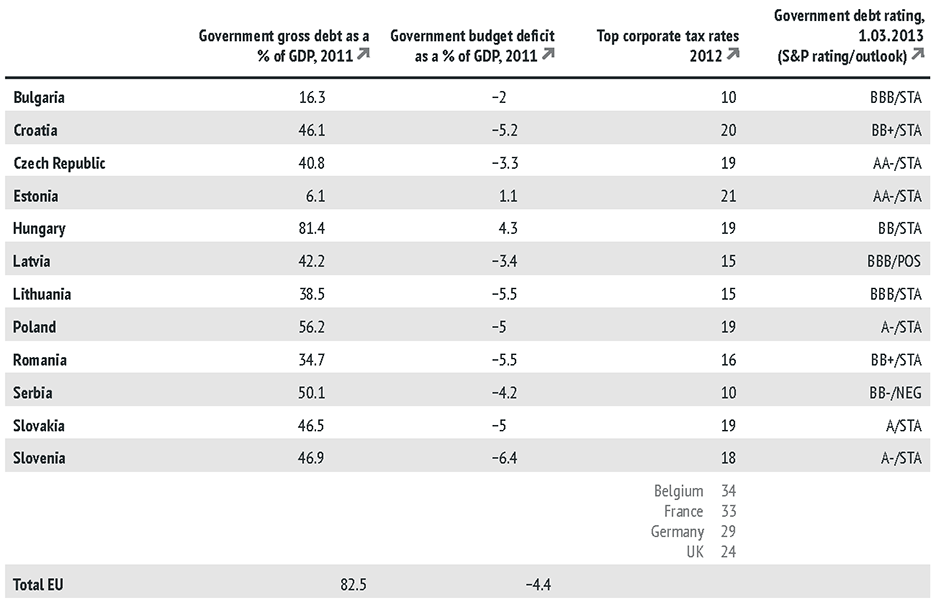
Private equity in CEE began almost as soon as the Berlin Wall fell. The first
funds were established and started activities across the region in 1990 and
the region witnessed successive waves of fundraisings in the mid-1990s,
early 2000s and late 2000s. Investment activity in CEE over the years has
been dominated by funds established specifically for the CEE region.
It has become generally clear to GPs that to be successful in CEE, an on-the-
ground presence is required, and the most active fund managers are those
with teams established in the countries of CEE. Today one can find a wide
range of fund managers with wide ranging experiences that are experts in
the countries of CEE.
The EVCA has been tracking CEE as a specific region since 2003. The annual
EVCA CEE Statistics¹ publications provide a detailed analysis of private equity
activity in the region. Key features are shown opposite.
CEE ANNUAL FUNDRAISING,
INVESTMENTS AND EXITS 2003–2011
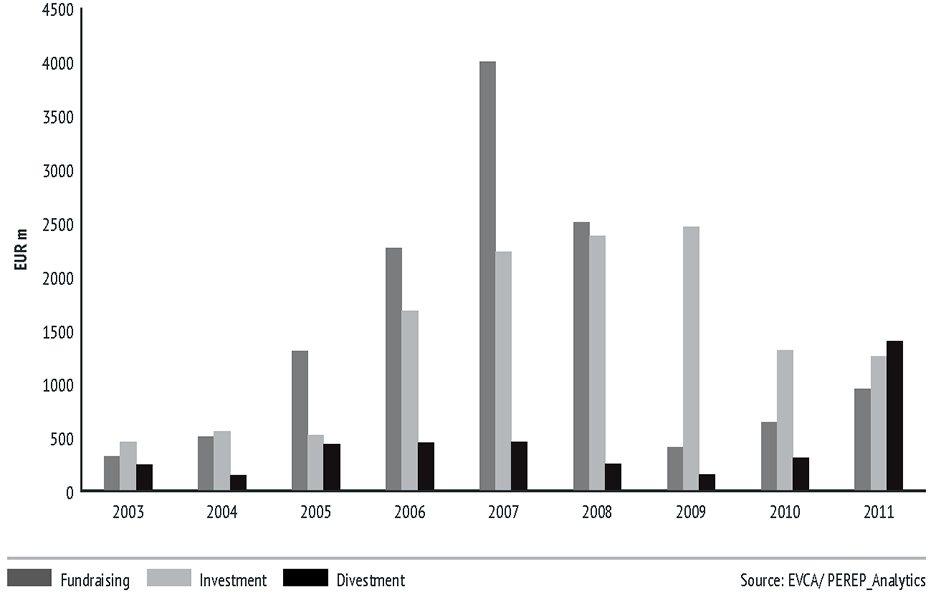
AGGREGATE SECTORIAL AMOUNTS INVESTED
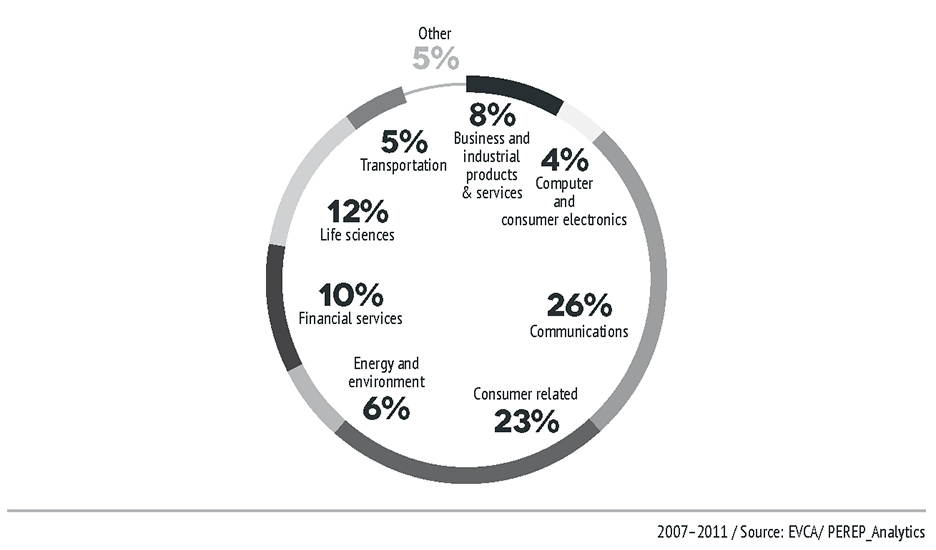
Location, location, location
Area / Population / GDP
Established private equity markets
Data on PE / VC market in CEE / Number of IPOs
An underfunded market
Data on PE / VC market in Europe and CEE /
Data on PE / VC market in Asia /
GDP for Emerging Asia
Experienced, institutional quality GPs
All data in this chapter come from an independent
survey of CEE GPs conducted in 4Q 2012.
CEE private equity has performed
Returns for CEE – EBRD, compilation for this report
Returns for Europe /
Returns for Emerging Markets
Unique deal flow
All data in this chapter come from an independent
survey of CEE GPs conducted in 4Q 2012.
Development of number of enterprises
Convergence: a globally unique story
GDP based on PPP per capita / Employment in services
Growth
Real GDP growth
Final consumption expenditure of households
Domestic credit to the private sector as percentage of GDP /
Government debt as percentage of GDP
Capital flows drive growth and opportunity
Foreign direct investments: stock and inflow /
EU
budget allocation to CEE /
Data on job creation by
shared service and R&D centres /
PAIiIZ /
Wage adjusted
labour productivity /
Hourly labour cost
Active loan markets; moderate leverage
Debt to EBITDA in Europe and CEE /
An independent survey of CEE GPs conducted in 4Q 2012.
The region
Population, GDP at current prices /
GDP based
on PPP per capita /
Percentage of economy for
exports /
Current Account
Balance as a percentage of GDP /
Government gross debt as a percentage of GDP /
Government deficit as a percentage of GDP /
Corporate tax rates 2012 /
Government Debt Rating (1/3/2013)
Private equity in CEE
All the data on PE/VC market in Europe and CEE come from EVCA
PSIK –Polish Private Equity and Venture Capital Association
www.psik.org.pl
HVCA –
Hungarian Private Equity and Venture Capital Association
www.hvca.hu
CVCA –
Czech Private Equity and Venture Capital Association
www.cvca.cz
SLOVCA –
Slovak Venture Capital and Private Equity Association
www.slovca.sk
SEEPEA –
South Eastern Europe's Private Equity Association
www.seepea.org
CVCA –
Croatian Private Equity and Venture Capital Association
www.cvca.hr
LTVCA –
Lithuanian Venture Capital Association
www.vca.lt
EstVCA –
Estonian Venture Capital Association
www.cvca.hr
LVCA –
Latvian Private Equity and Venture Capital Association
www.lvca.lv
Alvarez & Marsal
Leading global professional services firm, Alvarez
& Marsal (A&M), works with companies and
investors to drive business performance and solve
complex business challenges. Whether serving as
trusted advisors or as interim leaders, A&M delivers
specialist operational, consulting and industry
expertise to overcome hurdles and maximize value
across the enterprise and investment lifecycles.
From more than 40 locations, including offices
in Warsaw, Prague and Moscow, A&M works with
private equity firms to “buy right, manage right and
sell right.” When action and results matter most,
visit www.alvarezandmarsal.com or contact Tom
Kolaja, Managing Director, at +48 22 397 82 00
or e-mail: tkolaja@alvarezandmarsal.com.

Deloitte
Deloitte Central Europe serves organizations with
world class Audit, Tax, Consulting and Financial
Advisory. Through the network of independent
legal entities it operates seamlessly across
the 17 countries of Central Europe. The regional
Financial Advisory practice combines a powerful
mix of highly experienced local and international
experts in the areas of Corporate Finance Advisory,
M&A Transaction Services, Valuation Services
and Reorganisation Services. Since 1990, Deloitte
Central Europe has advised on hundreds of
transactions, and has built a number of market
leading service lines and an excellent client base.
Contact: Garret Byrne, Private Equity Leader, e-mail:
gbyrne@deloittece.com, tel.+420 246 042 339.

White & Case
White & Case’s Private Equity practice in Central
and Eastern Europe and Turkey (CET) has a
formidable track record on complex, cross-border
private equity deals, offering an integrated team
of English, US and locally qualified private equity
lawyers and tax advisors. We have offices in 7
jurisdictions in CET: Ankara, Bratislava, Bucharest,
Budapest, Istanbul, Prague and Warsaw. Across the
CET region, we have over 120 private equity and
M&A lawyers, with strong supporting leveraged
finance and tax structuring. White & Case’s Private
Equity team in CET has served as international
transaction counsel on ground-breaking
transactions throughout CET.

This paper was inspired by the CEE general
partner community’s desire to set out the basic
facts about the attractions of a region often lost
in the characterizations of developed Europe and
overshadowed by the focus on trendy emerging
markets.
Special thanks to William Watson (Value4Capital),
Robert Manz (Enterprise Investors), and Barbara
Nowakowska (PSIK - Polish Private Equity and
Venture Capital Association) for their leadership
in the development of this paper. Kimberly
Romaine (private researcher) is also recognized
for her research, in particular co-ordinating the GP
survey of late 2012 to ensure its independence.
In addition, Henry Potter (Alpha Associates), Chris
Mruck (Advent International), and Craig Butcher
(Mid Europa Partners) contributed greatly to the
development and editing of the paper.Thanks also
to the European Private Equity and Venture Capital
Association (EVCA) for their support on CEE statistical
data. And last but not least, thanks to the European
Bank for Reconstruction and Development (EBRD)
for compiling and sharing their return data,
the most comprehensive in the CEE region.
Disclaimer
The information contained in this report has been compiled
by PSIK based on the sources noted throughout this paper.
While the authors have taken suitable steps to ensure the
reliability of the information included in this report, neither
they, the supporting private equity associations nor the Partners
can guarantee the accuracy of the information collected and
presented herein. Therefore, no responsibility for any decision
made or action taken based upon this report or the information
provided herein can be accepted by the authors, any of the
supporting private equity associations nor the Partners .
© Copyright PSIK April 2013